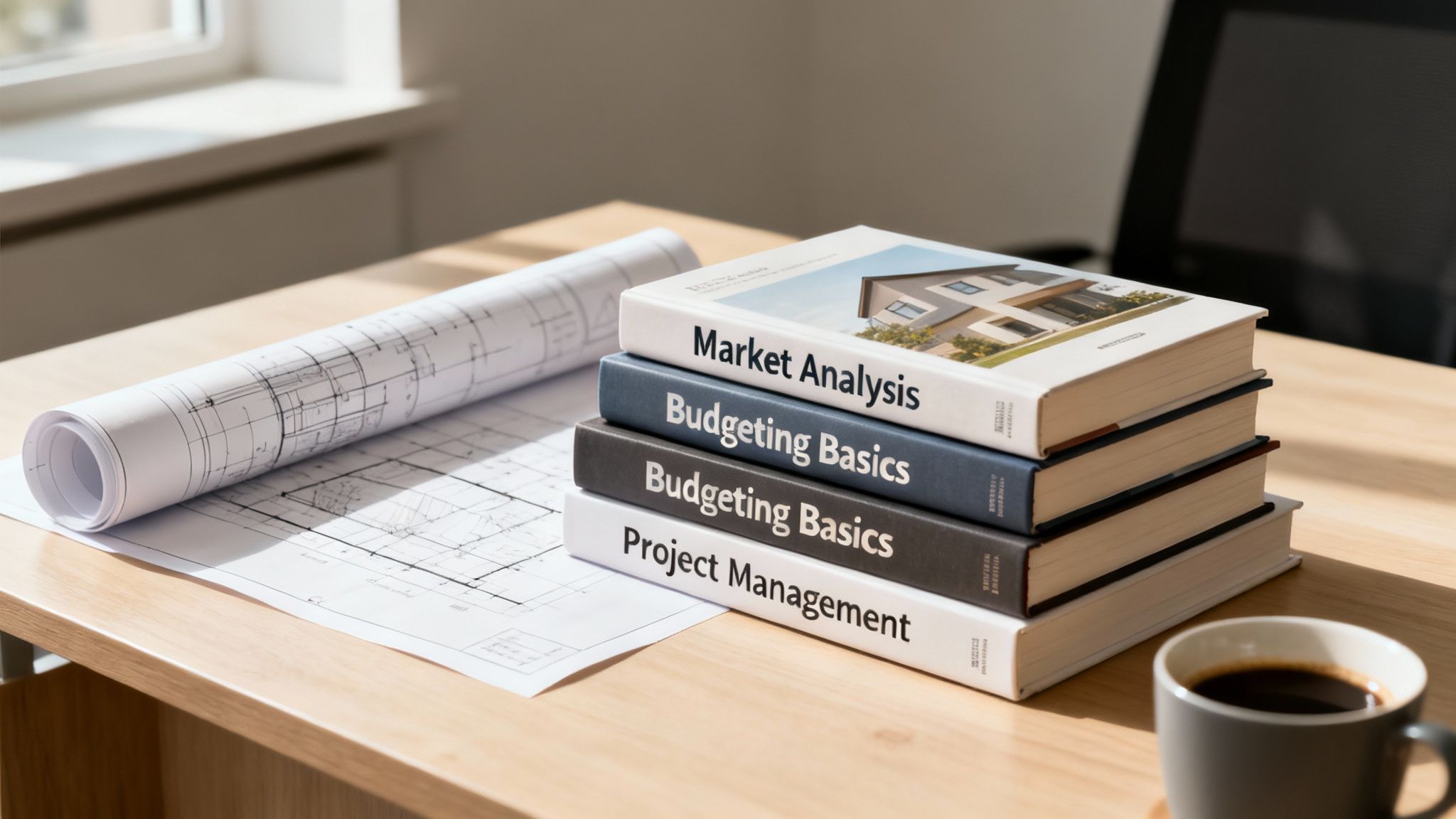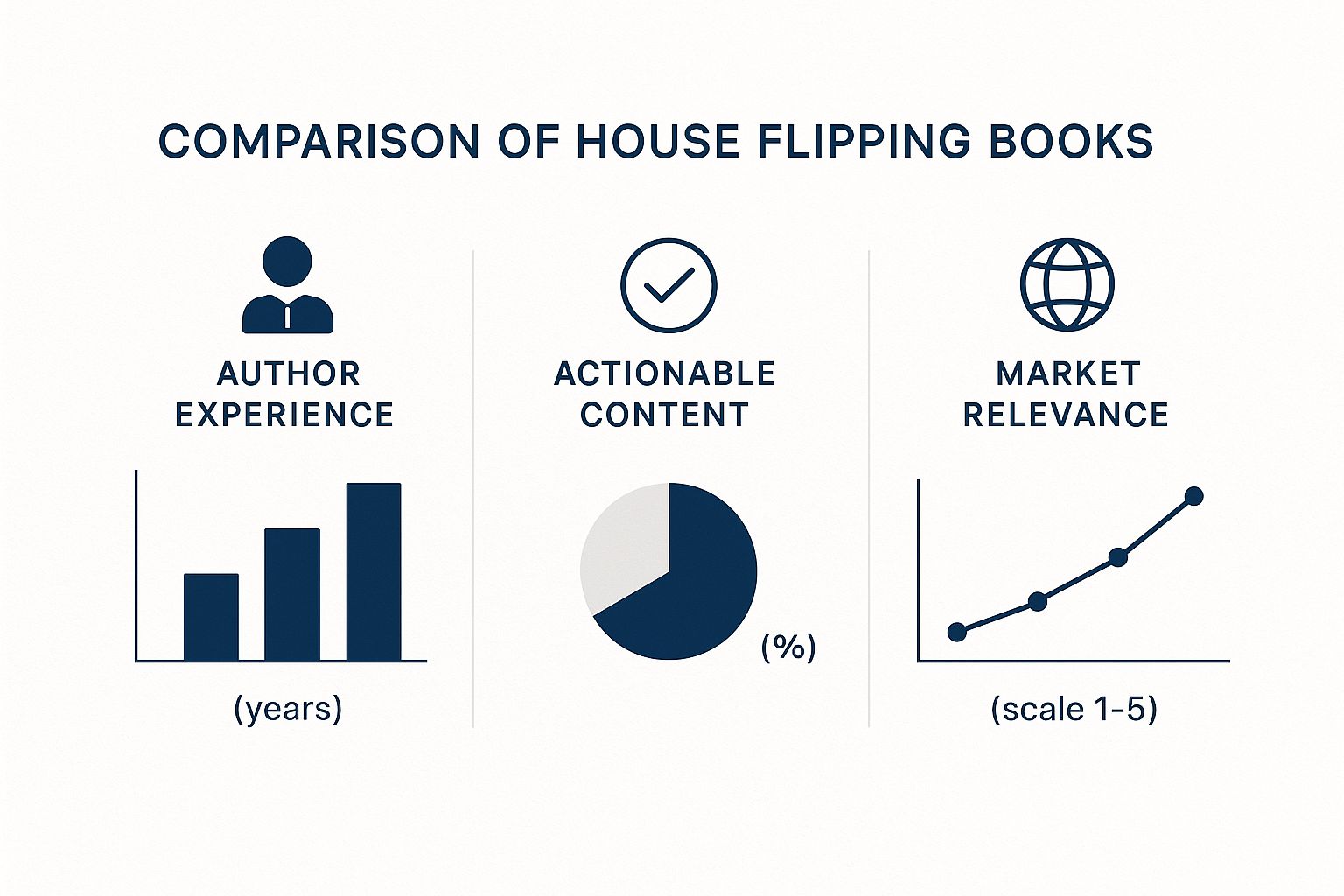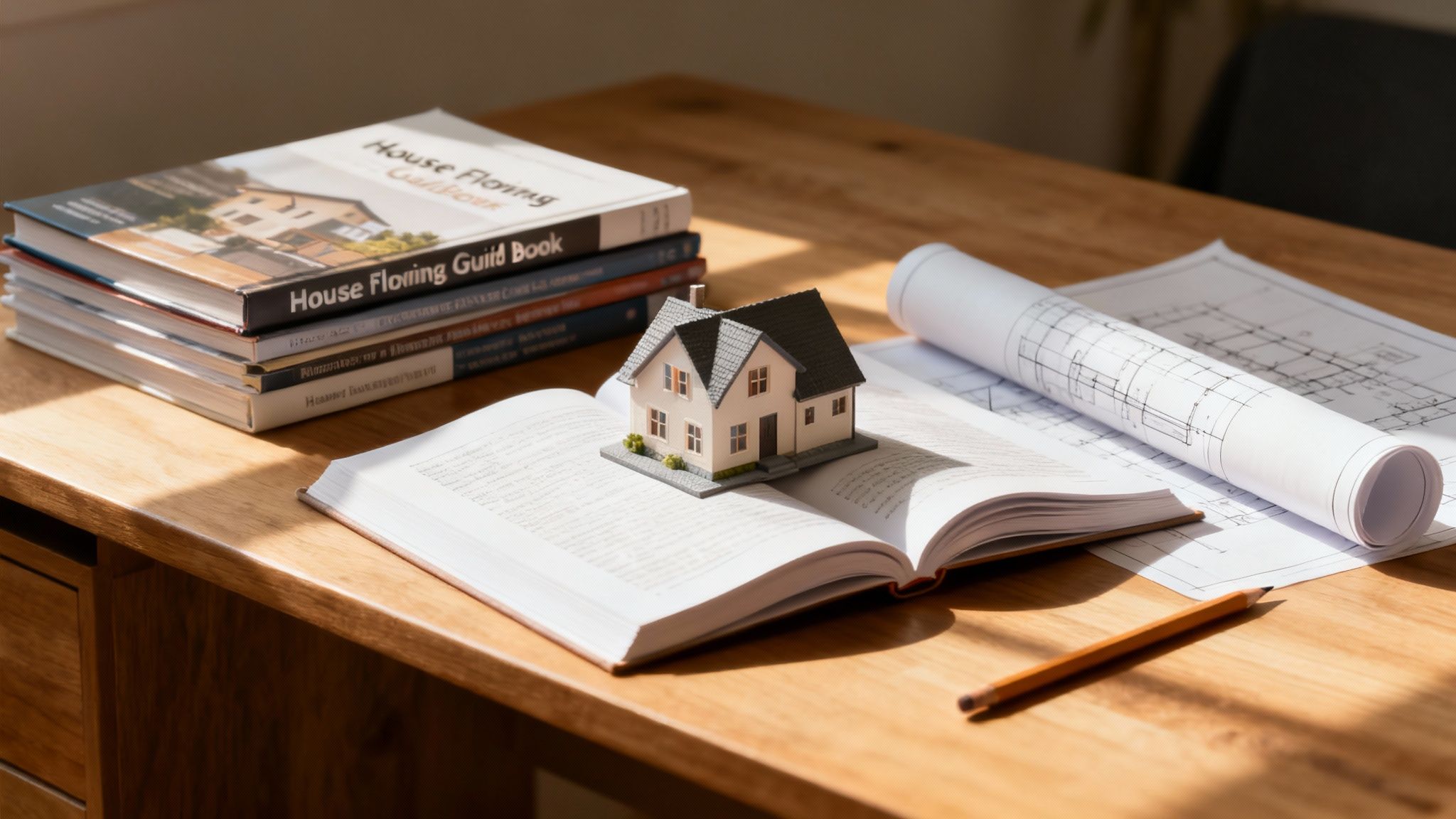Jumping into real estate investing without a plan is a recipe for disaster. The best books on flipping houses are your blueprint, your first real mentor in this game. Think of that $20 you spend on a book not as an expense, but as your first, and smartest, investment—one that can save you from thousands in rookie mistakes.
Why a Book Is Your First and Best Investment

Before you ever walk a property or swing a hammer, your journey should start by turning some pages. It's easy to get caught up in the glamour of house-flipping shows, but what they don't show you is the painstaking planning and financial discipline it takes to actually turn a profit.
That's where a good book comes in. Unlike a TV show that breezes through a flip in 30 minutes, a book forces you to slow down and really absorb the core principles. You get decades of hard-won experience distilled into actionable advice.
The Groundwork for Sustainable Success
A solid educational foundation is what separates the pros from the people with horror stories. The right books give you the mental tools to make smart, calculated decisions instead of emotional ones. This is the stuff you absolutely have to know:
- Financial Literacy: Getting a handle on concepts like the 70% Rule, After Repair Value (ARV), and how to actually get a loan. In simple terms, ARV is what your property will be worth after all the renovations are complete.
- Market Analysis: Learning to spot the difference between a rundown house and a genuine money-making opportunity.
- Project Management: Understanding how to create a realistic renovation budget and timeline—and how to manage contractors without pulling your hair out.
- Risk Mitigation: Recognizing the common traps, from a busted foundation to a sudden market dip, and having a plan B.
The real goal isn't just to survive your first flip. It's to build a repeatable system that you can use again and again. The wisdom in these books is what helps you create that very system, turning a one-off project into a real business.
For a deeper dive into getting started, our guide on how to get into flipping houses breaks it down even further. When you combine that knowledge with the practical advice from seasoned flippers, you’re setting yourself up to handle the real-world chaos.
Ultimately, a few hours spent reading is a tiny price to pay to avoid months of frustration and thousands of dollars in losses on your first deal.
How to Choose Your First House Flipping Book
Walking into the business section of a bookstore—or scrolling through Amazon—can feel like a tidal wave of information. Dozens of authors are all promising the secret sauce to real estate riches. But here's the truth: not all books on flipping houses are created equal.
Choosing the right one isn't about finding some magic "best" book. It's about finding the best book for you, right where you are today.
Think of it like hiring a mentor. You wouldn't hire a coach specializing in luxury high-rises if you're trying to flip a small single-family home in the suburbs. Your first book needs to align with your actual goals, your budget, and the reality of your local market. A great book strikes that perfect balance between high-level strategy and the nitty-gritty, actionable steps you can put to work tomorrow.
Focus on Verifiable Experience
The very first filter you should use is the author's background. Look for authors who are seasoned, active investors with a track record you can actually verify. Their wisdom comes from real-world wins and, more importantly, from expensive mistakes.
These are the people who have been in the trenches. They've dealt with shady contractors, negotiated with stubborn sellers, and navigated those heart-stopping, unexpected budget blowouts. An author with genuine experience will fill their pages with detailed case studies and practical examples, not just vague motivational fluff. They get the difference between clean theory and the messy reality of a renovation project.
Quick Takeaway: Prioritize books written by practitioners, not just theorists. Real-world flipping experience translates into credible, honest advice that can save you from the most common and costly rookie mistakes.
Align the Book with Your Needs
Let's be honest—every aspiring flipper has different strengths and weaknesses. Maybe you're a numbers wizard who gets lost when it comes to design. Or perhaps you can swing a hammer with the best of them but break into a cold sweat thinking about financing. Be real about your knowledge gaps and hunt down books that fill them.
- Need help with financing? Look for titles that dedicate entire chapters to creative financing, hard money loans, and finding private lenders.
- Struggling with project management? Find authors who provide sample budgets, renovation checklists, and tips for hiring and managing contractors.
- Clueless on deal analysis? Choose books that give you in-depth formulas and step-by-step guides for calculating After Repair Value (ARV) and estimating costs.
The infographic below breaks down the key things to look for in a book, weighing the author's real-world experience against how practical the content is and whether it’s still relevant today.

This visual guide shows that the most valuable books are the ones scoring high across all three categories. They offer a balanced, effective way to learn. Honestly, building a small, personalized library of two or three specialized books is often way more powerful than relying on a single general guide. This approach ensures you've covered all your bases, from finding the deal to cashing that final check.
The Core Library For Aspiring House Flippers

Alright, now that you know how to pick a winner, let's talk about the must-haves for your bookshelf. Some books on flipping houses are more than just good reads—they're practically rites of passage. They’ve earned their place by laying out systems that simply work, decade after decade.
Think of these books as your foundational toolkit. They aren't just collections of tips; they're complete business plans hiding in plain sight, giving you the frameworks and formulas to tackle your first few deals without flying blind.
Here’s a quick look at the heavy hitters before we dive deep into what makes each one essential.
Top House Flipping Books at a Glance
| Book Title | Author | Core Focus | Best For |
|---|---|---|---|
| The Book on Flipping Houses | J Scott | Creating a repeatable, systematic flipping business from A to Z. | Analytical beginners who want a step-by-step business plan. |
| FLIP: How to Find, Fix, and Sell Houses for Profit | Rick Villani & Clay Davis | Market-specific strategy, team building, and mastering local conditions. | Investors who want to understand how to adapt their strategy to their market. |
| The Book on Estimating Rehab Costs | J Scott | Mastering the art and science of creating accurate renovation budgets. | Anyone serious about not losing their shirt on rehab overages. |
These books have been the launchpad for countless successful flippers, and the wisdom inside is just as relevant today as it was ten years ago. Let's break down why.
The Book on Flipping Houses by J Scott
If you buy only one book on this list, make it this one. J Scott’s guide is the polar opposite of motivational fluff. It's a dense, practical, and repeatable system for turning flipping into a legitimate business. It’s the closest you’ll get to a "business-in-a-box" for real estate investors.
Scott’s whole philosophy is built on a simple premise: treat flipping like a business, and businesses need predictable systems to succeed. He takes massive topics—finding deals, locking down financing, managing contractors, and marketing the final product—and breaks them into clear, actionable steps.
- Quick Takeaway: The book is packed with incredibly detailed checklists and worksheets for everything from initial property analysis to creating a bulletproof scope-of-work for your crew.
- Who Needs It: This is the perfect starting point for the analytical beginner who craves structure and wants to eliminate as much guesswork as possible.
“The goal is not to get lucky on one deal; the goal is to build a machine that produces profitable deals over and over again.”
That one quote captures the entire essence of the book. It’s about shifting your mindset from a gambler hoping for a big score to a business operator building a predictable profit engine. That shift is the real secret to lasting in this game.
FLIP: How to Find, Fix, and Sell Houses for Profit by Rick Villani and Clay Davis
While J Scott gives you the system, Villani and Davis drill down on strategy and building your A-team. Their core argument is that successful flipping isn't just about crunching numbers; it's about deploying the right strategy with the right people in your specific market.
Where this book really shines is in teaching you how to read your local market. It shows you how to figure out if a quick cosmetic flip, a full gut job, or something in between will bring the highest return in your neighborhood. You can't just apply a generic formula everywhere, and this book explains why.
Its biggest strength, though, is its focus on assembling a reliable team. It gives you practical, real-world advice for finding, vetting, and managing everyone from investor-savvy agents to contractors who actually show up. It hammers home the point that real estate is a team sport.
The Book on Estimating Rehab Costs by J Scott
This book is the essential companion to any general flipping guide. Why? Because the #1 reason flips go belly-up is a blown renovation budget. This book is a masterclass in preventing that disaster before it ever starts.
J Scott provides a methodical, almost scientific, way to walk a property and estimate every single repair cost, room by room and line item by line item. It’s not glamorous, but it’s critical.
It teaches you how to build a detailed scope of work, which is your best defense against contractor "misunderstandings" and surprise costs. Getting your numbers right is everything, and this book provides the deep, granular detail you need to truly master this skill.
These foundational books teach the evergreen principles of real estate. While specific market numbers change, the strategies for finding, funding, and fixing a property remain invaluable. Knowing your stuff has never been more critical.
Putting Your Reading into Real-World Action
All the knowledge you get from the best house-flipping books is just theory until you put it to work. This is the moment where the rubber meets the road—where you transform what you've read into an intelligent, real-world investment strategy.
Think of core principles like the 70% Rule as your starting blueprint. This classic formula says you should pay no more than 70% of a property's After Repair Value (ARV), minus the estimated repair costs. It’s a battle-tested way to build a profit margin right into your deal. But in today's market, you have to know how to adapt this wisdom.
Applying Formulas to Live Listings
Your first practical step is to take these formulas and run them against actual properties on the market. Start browsing online listings not like a dreamer, but like a seasoned analyst. For every house that catches your eye, run the numbers as if you were about to make a real offer.
- Step 1: Calculate the ARV. Find recently sold, renovated homes ("comps") in the same neighborhood. This is your target sale price.
- Step 2: Estimate Repair Costs. This is where most beginners get stuck. Use the detailed guides from your books to create a quick, preliminary budget for everything from paint to a new kitchen.
- Step 3: Run the 70% Rule. Multiply your ARV by 0.70, then subtract your estimated repair costs. That final number is your Maximum Allowable Offer (MAO).
Example in Action:
A house is listed for $220,000. Comps of similar renovated homes point to an ARV of $350,000. Your back-of-the-napkin repair estimate is $60,000.
- $350,000 (ARV) x 0.70 = $245,000
- $245,000 - $60,000 (Repairs) = $185,000 (Your MAO)
In this scenario, the $220,000 asking price is way too high to work with this formula. This quick five-minute exercise just saved you from a potential money pit.
Creating a Modern Renovation Budget
Once you move past the numbers, putting your reading into action means making smart renovation choices. Your goal isn't to build your dream home; it's to create a profitable product. Focus your budget on updates that deliver the biggest bang for your buck. Check out these top home renovation return on investment ideas to see what buyers are actually paying for. Hint: It's usually kitchens and bathrooms.
Market conditions always change. While flipping activity and profit margins fluctuate with interest rates and inventory, the core process remains the same. A well-executed flip, based on solid numbers, can be successful in any market. This makes managing your holding costs—like mortgage, taxes, and insurance—and your renovation timeline more critical than ever.
A detailed plan is the only way to stay on track. Our comprehensive flipping houses checklist is designed to help you turn book knowledge into a repeatable process, ensuring no critical step gets missed from day one to closing day.
Assembling Your Professional Flipping Team

If you read enough house-flipping books, one lesson gets hammered home again and again: you absolutely cannot do this alone. This isn't a solo mission. Flipping is a team sport, and the quality of your roster directly determines whether you win or lose.
Think of yourself as the general manager. The books give you the playbook, but your team is the crew that executes the plays on the field. One weak link—a slow agent, an unreliable contractor—can sabotage the entire project.
Building this network isn't just a one-time task you check off a list. It’s the ongoing process that turns your side hustle into a real, scalable business. Your team is what transforms the knowledge on a page into actual profit in your bank account.
Your Core Four Essential Players
To pull off a flip without losing your mind, you need a handful of key professionals in your corner. These people aren't just vendors; they're your partners. You need pros who understand the speed and unique pressures of real estate investing.
Here are the four non-negotiable roles you need to fill:
- The Investor-Friendly Real Estate Agent: This is not your cousin who just got their license. You need an agent who lives and breathes investment properties—someone who hunts for distressed deals, knows how to run the numbers, and can write a competitive offer at a moment's notice.
- The Trustworthy General Contractor: This person is arguably the most important player on your team. A great GC communicates clearly, respects the budget, and delivers quality work on schedule. A bad one can single-handedly bankrupt your project. It’s that simple.
- The Creative Lender: Whether you’re using a traditional bank or a private hard money lender, you need someone who gets it. A good lender understands the financing needs of flippers, can fund deals quickly, and offers loan products built for short-term renovation projects.
- The Sharp Real Estate Attorney or Title Company: This is your defense. This professional makes sure your deals close cleanly and legally, handling everything from title searches to contract reviews. They protect you from the legal landmines that can blow up your entire investment.
How to Find and Vet Your Team
Finding these experts takes more than a quick Google search. The absolute best way to build a killer team is through referrals. Get out there and network. Go to local real estate investor meetups and ask the people doing deals who they trust.
When you're interviewing potential team members, ask pointed, investor-focused questions. For an agent, try: "How many off-market deals have you found for clients this year?" For a contractor, insist on references from their last three jobs—and actually call them.
Your goal here is to build long-term relationships. Once you find good people, treat them like gold. Pay them on time, respect their expertise, and bring them repeat business. A loyal, skilled team will become your greatest asset, giving you the confidence and manpower to tackle bigger and more profitable deals down the road.
Frequently Asked Questions
Can I really start flipping with no money after reading these books?
While many books explain how to use other people's money (OPM) through hard money loans or private lenders, "no money down" rarely means zero cost to you. You'll typically still need cash for a down payment (often 10-20%), closing costs, and holding costs like insurance and taxes. The books are your guide to understanding these financing strategies, not a magic ticket to a cost-free investment.
Are older house flipping books still useful today?
Absolutely. Core principles like the 70% Rule, accurate cost estimating, and solid project management are timeless. These fundamentals of creating value and managing risk don't change. However, you must apply these principles using today's numbers, accounting for current interest rates, material costs, and local labor prices.
How many books should I read before my first flip?
Aim to read two or three highly-rated books to get a well-rounded perspective. This prevents you from getting stuck on one author's strategy and exposes you to different approaches. After you've built that foundational knowledge of the entire process (finding, funding, fixing, and selling), the best teacher is real-world experience analyzing actual deals in your market.
Ready to stop guessing and start analyzing properties with confidence? Flip Smart gives you the power to evaluate any deal in seconds. Get accurate valuations, rehab cost estimates, and profit projections instantly, so you can make smarter, faster investment decisions. Start your free trial at flipsmrt.com and turn your knowledge into profitable action.
